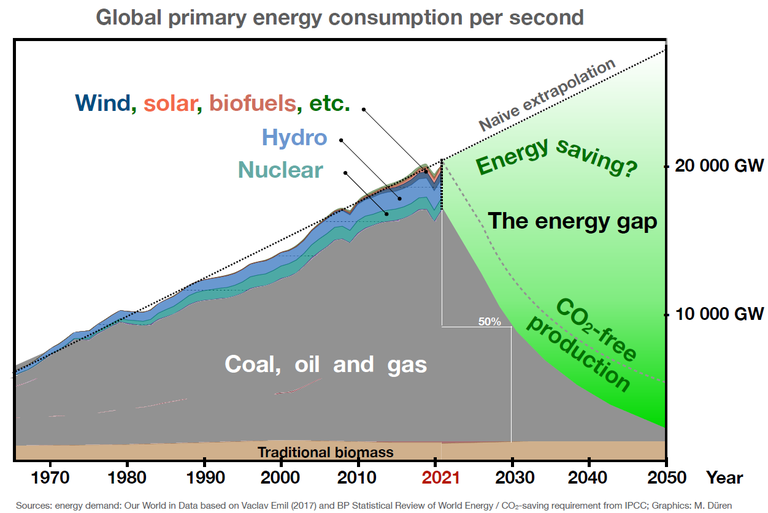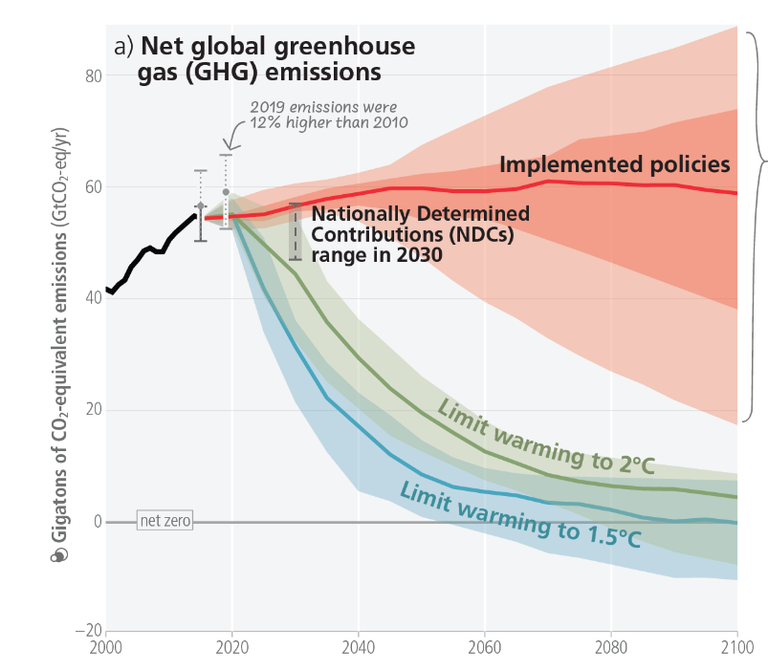Non-fossil energy: A Global Challenge for Climate Protection
Edition 66 | April 2023
• Today, around 80 percent of mankind's primary energy needs are met by fossil fuels.1
• Climate protection requires a halt to net CO2 emissions by 2050.2
• Climate change doesn't wait: The pace of change to a non-fossil energy world must be accelerated with all possible speed.
As early as 1987, the German Physical Society, together with the German Meteorological Society DMG, published the call "Warning of impending global climate change due to human activity "3.
Rapid changes in the climate with an average increase in the earth's temperature of more than 1.5°C will have risks for life, world food and biodiversity that are difficult to assess4,5. To avoid this, science therefore calls for a rapid reduction of net CO2 emissions down to zero. The situation is aggravated by so-called climate tipping points6, at which warming due to additional effects, such as the melting of the Arctic ice, continues and is difficult to predict whether it is accelerated.
Recent calculations show that some of them could already be exceeded at an average warming of less than 2°C or are already exceeded today.
Nevertheless, the share of fossil fuels in meeting the world's total energy demand has remained almost constant to date at around 80%1. Modern solar and wind power plants – just like nuclear energy – each contribute only about 4%1.
The use of fossil fuels must be ended worldwide by 2050 at the latest2 to limit global warming to 1.5°C with a certain degree of confidence. To achieve this, around 140 million gigawatt hours (GWh) per year must be replaced by non-fossil energy forms; this corresponds theoretically to the energy output of 16,000 conventional power plants.
The challenge is huge, and it is global. Germany contributes about 2 % and Europe about 14 % to the total CO2 emission. Nevertheless, the efforts to reduce emissions in Europe are important and pioneering, especially regarding the responsibility and role model function of the industrialized countries. These have a duty to develop the path to transform society while maintaining the competitiveness of business and industry in the global marketplace and, in addition, to help financially weak countries so that they too can achieve net zero emissions by mid-century.
However, solar and wind energy are volatile. Storage and transport of the energy generated from these sources require a massive expansion of electrochemical and chemical storage systems (batteries, hydrogen, methane, ammonia, etc.) as well as heat and pump storage systems. For the latter, there are innovative concepts that use old mines and opencast mines.7
Saving energy is particularly important and must be pursued consistently. This includes efficient thermal insulation of buildings, heating with heat pumps8, lighting with LEDs and much more, right up to a fundamental redesign of mobility and its forms of propulsion.
Climate change will not wait: The figures make it clear that the pace of the energy turnaround must be accelerated with all our might. This requires, in particular, a political framework such as emissions trading and realistic CO2 pricing, as well as the removal of obstacles to the development of a climate-friendly energy and transport system.

Drastic reduction of fossil fuels
The drastic reduction in greenhouse gas emissions deemed necessary by the Intergovernmental Panel on Climate Change to achieve the goals of the Paris Agreement is here schematically applied to fossil energy production10.

CO2 emissions must be drastically reduced to prevent with some certainty an irreversible climate catastrophe (blue curve)9.
Footnotes and sources
1) For comparability of different primary energies, the substitution method was used. In the substitution method (direct method), the share of fossil energy sources is 77% (86%) and that of nuclear energy is 4% (1.8%). "Our World of Data";
https://ourworldindata.org/energy-production-consumption
2) IPCC, The Physical Science Basis; Summary for Policymakers, Climate Change 2019; https://www.ipcc.ch/site/assets/uploads/sites/2/2018/07/SR15_SPM_version_stand_alone_LR.pdf
3) Joint appeal of the German Physical Society and the German Meteorological Society published in Phys. Bl. 43 (1987) No. 8; https://www.dpg-physik.de/veroeffentlichungen/publikationen/stellungnahmen-der-dpg/klima-energie/warnung-vor-drohenden-weltweiten-klimaaenderungen-durch-den-menschen
(in German only)
4) Mora et al, Nature, Climate Change 7, 501-506 (2017) and IPCC, Impacts, Adaptation and Vulnerability, Summary for Policy- makers; https://www.ipcc.ch/report/ar6/wg2/downloads/report/IPCC_AR6_WGII_SummaryForPolicymakers.pdf
5) Global Assessment Report on Disaster Risk Reduction, United Nations, GAR2022, May 2022; https://www.undrr.org/gar2022-our-world-risk-gar
6) Exceeding the 1.5°C global warming could trigger multiple climate tipping points; Science, Vol. 377, No. 6611, 2022.
7) Electricity: Key to a sustainable and climate-friendly energy system (DPG 2010 / Working Group Energy); https://www.dpg-physik.de/veroeffentlichungen/publikationen/studien-der-dpg/pix-studien/studien/energy_2011.pdf
and G. Luther, H. Schmidt-Böcking, "Pumped storage power plant with a storage reservoir enclosed by a ring dam" Offenlegungsschrift DE 10 2021 004 099 A1; https://patentimages.storage.googleapis.com/b3/e4/9f/5a792b256d149a/DE102021004099A1.pdf
8) See Physikkonkret No. 49 "Wärmepumpe versus Kraft-Wärme-Kopplung"; https://www.dpg-physik.de/veroeffentlichungen/publikationen/physikkonkret/waermepumpe-versus-kraft-waerme-kopplung
(in German only)
9) IPCC_AR6_WGIII_Full_Report, Fig. TS 9, page TS-29;
https://report.ipcc.ch/ar6/wg3/IPCC_AR6_WGIII_Full_Report.pdf
10) Energy consumption to date from "Our World of Data"; https://ourworldindata.org/energy-production-consumption